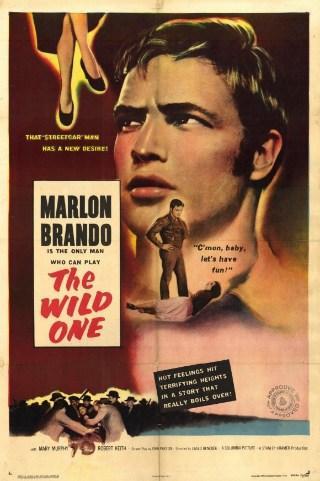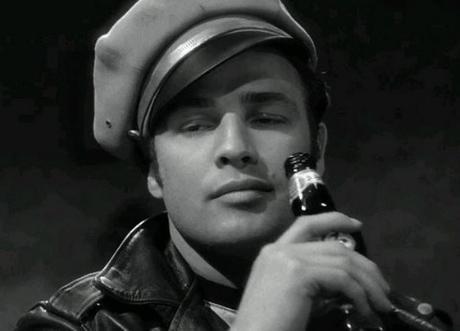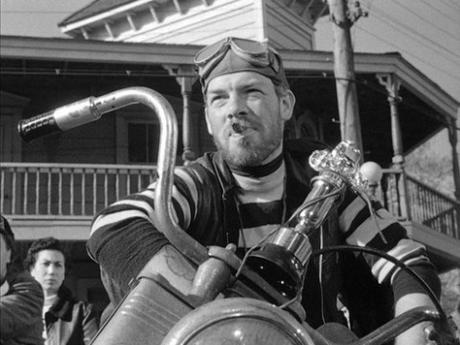
Hey Johnny, what are you rebelling against?Whadda you got?
James Dean was not the first American teenager nor was he the first screen rebel, with or without a cause. Sure we all know that but one would be forgiven for thinking it were actually so if some commentaries on the development of social issues in the movies are held to be true. Disaffected youth had, to a greater or lesser extent, been present on screen for a much longer time; you could make a case for some of the pre-war crime/gangster movies, and a far stronger one for later noir-style disillusionment such as They Live by Night (courtesy of Nicholas Ray, who would of course cast the aforementioned Dean in his most iconic role) or Lewis' Gun Crazy. No, young people had been butting heads with society for quite a while but the 1950s with the attendant changes of the aftermath of the war seemed to make the phenomenon appear, if not unprecedented, at least more marked. The Wild One (1953), while it no longer retains the same impact, must have provoked a reaction at the time both for its frank approach to its subject matter and the style and attitude of the star.
The opening is one of those ominous warnings about the events about to unfold being extreme yet perhaps indicative of some as yet ill-defined social malaise. And then the bikes and their riders appear and power their way towards the camera. Front and center is Johnny (Marlon Brando), looking tough and insolent in black leather and aviator shades. The bikers ride into a small town in the midst of a race, strutting and swaggering and soon being told to be on their way by the anonymous face of the law. They do so, but the next town they arrive in gets to host them a little longer. The bulk of the movie plays out here, as Johnny's rival Chino (Lee Marvin) turns up and duly encourages further displays of machismo and bravado. While the bikers become increasingly foolish in their boorishness, the locals (or a group with the local population) let their own boorishness grow ever more vindictive and mean. At the heart of it all is Johnny, simultaneously detached and driven, proud of his outlaw, outsider status yet also drawn to the sweet respectability of waitress Kathie (Mary Murphy).

The Wild One was inspired by events in the town of Hollister in 1947, when a motorcycle gang brought chaos to the small settlement with no apparent explanation. This is essentially what's going on in this movie, an outbreak of seemingly inexplicable anti-social behavior, a rejection of the comfortable affluence and respectability which characterized the decade following the end of the war in the US. Laslo Benedek, who had a long and wide-ranging career in television was the director and provided some nice moody visuals, particularly the scenes taking place during the climactic evening. Still, the fingerprints which are even more in evidence are those of producer Stanley Kramer. He is best known for his message films and The Wild One is the type of vehicle you'd expect him to be involved with even without seeing his name attached to the credits.
Without wishing to belittle any of the other members, and there is a long and solid supporting cast, the film mainly revolves around four people - Brando, Marvin, Murphy and Robert Keith. Of these, Brando is obviously the focus; I can only imagine how different his persona was when he came on the scene in the post-war years. That mumbling, brooding Method approach to his art was always going to mark him out in a world still dominated by naturalistic and theatrically trained performers. Frankly, it's not a style I'm overly fond of and I suspect that how one reacts to The Wild One will be strongly influenced by how one takes to Brando. Marvin was a terrific foil to Brando's mannered intensity, the brash exuberance still feeling fresh, elemental and somehow more real. Similarly, Murphy's demure classiness offers another point of contrast, and a very appealing one too. And last but not last, is the quiet presence of Keith, serving up a finely judged study of weakness and self-doubt. As for those supporting players, Will Wright, Ray Teal, Jay C Flippen and Timothy Carey are just a few of the familiar and reliable faces on show.

The Wild One is now another of the consistently strong series of Dual format Blu-ray/DVD releases from Powerhouse/Indicator in the UK. Although I don't have any other Hi-Def release of the movie to make a comparison I feel this is a very strong presentation - it's clean and sharp, has excellent contrast and the blacks look appropriately black. So, no issues on that score. The supplements are, as usual, copious and worthwhile. Jeanine Basinger provides the commentary track and there's a brief introduction by Karen Kramer. Then there are a number of featurettes: one on the films and its history with the BBFC, another on the events in Hollister that gave rise to the story, and finally there's a piece on Brando. Furthermore, there's a Super 8 version of the movie included alongside the trailer and a gallery. The accompanying booklet runs to a satisfying 40 pages and includes an article by Kat Ellinger, an article from 1955 by director Benedek on the movie, a piece by Leslie Halliwell and comments from critics of the time.
The Wild One is a well-made, pacy and influential film. I can't claim it's a great favorite of mine but that's at least partly down to my own ambivalence to Brando as an actor and shouldn't be taken as any dismissal of the artistic and intellectual merits of the movie. For those who appreciate Brando's work more the film will probably be a more satisfying experience. That aside, it's a good movie and the new release is a top quality one, something which is now typical of Indicator.
